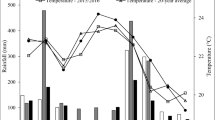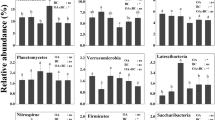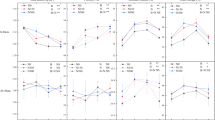Abstract
The application of biochar with inorganic fertilizers is shown to improve crop productivity. However, resource-poor farmers may be constrained in their ability to meet the fertilizer requirements. In this short-term greenhouse research, we investigated whether combining biochar and green manure sources of Tithonia diversifolia and Vicia faba could be a viable soil management option for smallholder agroecosystems. Generally, the application of the green manures either singly or mixed with biochar showed similar effects on soil properties. However, in contrast to mixed biochar and fertilizer treatments, soil microbial biomass C, mineral N, available P, and pH were generally higher in soils that received mixed green manure and biochar applications. The results also showed a positive but comparable synergistic effect of applying green manure or fertilizers with biochar. It was inferred that the combined applications of biochar and V. faba or T. diversifolia increased maize grain yield by 35 and 25 %, respectively, compared with sole V. faba and T. diversifolia applications. Relative to sole fertilizer application, there was a 27 % increase in maize grain yield when fertilizer was combined with biochar. The increased biological yield of maize in mixed than single treatments was attributed to the increased N use efficiency of maize plants that received mixed application of biochar and green manures or inorganic fertilizer. The results established that in places where inorganic fertilizers are limited, green manures could be applied with biochar for improved soil fertility and crop productivity.



Similar content being viewed by others
References
Beedy TL, Snapp SS, Akinnifesi FK, Sileshi GW (2010) Impact of Gliricidia sepium intercropping on soil organic matter fractions in a maize-based cropping system. Agric Ecosyst Environ 38:139–146
Brady NC, Weil RR (2004) Elements of the nature and properties of soils, 2nd edn. Prentice- Hall Inc, Upper Saddle River
Brookes PC, Powlson DS, Jenkinson D (1982) Measurement of microbial biomass phosphorus in soil. Soil Biol Biochem 14:319–329
Chowdhury MAH, Kouno K, Ando T, Nagaoka T (2000) Microbial biomass, S mineralization and S uptake by African millet from soil amended with various composts. Soil Biol Biochem 32:845–852
Cross A, Sohi SP (2011) The priming potential of biochar products in relation to labile carbon contents and soil organic matter status. Soil Biol Biochem 43(10):2127–2134
Eneji AE, Yamamoto S, Wen G, Inanaga S, Honna T (2005) Comparative evaluation of wet digestion and dry ashing methods for the determination of some major and minor nutrients in composted manure. Toxicol Environ Chem 87:147–158
Fageria NK, Baligar VC (2005) Enhancing nitrogen use efficiency in crop plants. Adv Agron 88:97–185
Garcı´a-Gil JC, Plaza C, Soler-Rovira P, Polo A (2000) Long-term effects of municipal solid waste compost application on soil enzyme activities and microbial biomass. Soil Biol Biochem 32:1907–1913
Houben D, Evrard L, Sonnet P (2013) Mobility, bioavailability and pH-dependent leaching of cadmium, zinc and lead in a contaminated soil amended with biochar. Chemosphere. doi:10.1016/j.chemosphere.2013.03.055
Ikerra ST, Semu E, Mrema JP (2007) Combining Tithonia diversifolia and Minjingu phosphate rock for improvement of P availability and maize grain yields on a chromic acrisol in Morogoro, Tanzania. In: Bation A, Waswa B, Kihara J, Kimetu J (eds) Advances in Integrated Soil Fertility Management in Sub-Saharan Africa: Challenges and Opportunities. Springer, Dordrecht, pp 333–344
Jama B, Kiwia A (2009) Agronomic and financial benefits of phosphorus and nitrogen sources in western Kenya. Expl Agric 45:241–260
Jama BA, Palm CA, Buresh RJ, Niang AI, Gachengo C, Nziguheba G, Amadalo B (2000) Tithonia diversifolia as a green manure for soil fertility improvement in western Kenya: a review. Agrofor Syst 49:201–202
Jeffery S, Verheijen FGA, Van der Velde M (2011) A quantitative review of the effects of biochar application to soils on crop productivity using meta-analysis. Agric Ecosyst Environ 144(1):175–187
Jensen ES, Peoples MB, Hauggaard-Nielsen H (2010) Faba bean in cropping systems. Field Crop Res 115:203–216
Joseph SD, Camps-Arbestain M, Lin Y, Munroe P, Chia CH, Hook J, Amonette JE (2010) An investigation into the reactions of biochar in soil. Soil Res 48(7):501–515
Kang BT (1991) Soil management and crop production in alley farming (IITA Research Guide 29). International Institute of Tropical Agriculture, Ibadan
Ladd JN, Amato M (1989) Relationship between microbial biomass carbon in soils and absorbance of extracts of fumigated soils. Soil Biol Biochem 21:457–459
Laird D, Fleming P, Wang B, Horton R, Karlen D (2010) Biochar impact on nutrient leaching from a Midwestern agricultural soil. Geoderma 58:436–442
Lehmann J, Gaunt J, Rondon M (2006) Bio-char sequestration in terrestrial Ecosystems: a review. Mitig Adapt Strat Glob Change 11:403–427
Liu J, Schulz H, Brandl S, Miehtke H, Huwe B, Glaser B (2012) Short-term effect of biochar and compost on soil fertility and water status of a Dystric Cambisol in NE Germany under field conditions. J Plant Nutr Soil Sc 175(5):698–707
Luo Y, Durenkamp M, De Nobili M, Lin Q, Brookes PC (2011) Short term soil priming effects and the mineralisation of biochar following its incorporation to soils of different pH. Soil Biol Biochem 43(11):2304–2314
Major J, Lehmann J, Rondon M, Goodale C (2010) Fate of soil-applied black carbon: downward migration, leaching and soil respiration. Glob Change Biol 16:1366–1379
Motsara MR, Roy RN (2008) Guide to Laboratory establishment for plant nutrient analysis. FAO Fertilizer and Plant nutrition bulletin. Food and Agriculture Organization, Rome p 219
Novak JM, Busscher WJ, Watts DW, Laird DA, Ahmedna MA, Niandou MA (2010) Short-term CO2 mineralization after additions of biochar and switchgrass to a Typic Kandiudult. Geoderma 154(3):281–288
Palm CA, Gachengo CN, Delve RJ, Cadisch G, Giller K (2001) Organic inputs for soil fertility management in tropical agroecosystems: application of an organic resource database. Agric Ecosyst Environ 83:27–42
Partey ST, Preziosi RF, Robson GD (2012) Effects of organic residue chemistry on soil biogeochemistry: implications for organic matter management in agroecosystems. In: Adewuyi B, Chukwu K (eds) Soil fertility: characteristics, processes and management. Nova Publishers, New York, pp 1–28
Partey ST, Preziosi RF, Robson GD (2013) Maize residue interaction with high quality organic materials: effects on decomposition and nutrient release dynamics. Agric Res 2(1):58–67
Partey ST, Quashie-Sam SJ, Thevathasan NV, Gordon AM (2011) Decomposition and nutrient release patterns of the leaf biomass of the wild sunflower (Tithonia diversifolia): a comparative study with four leguminous agroforestry species. Agrofor Syst 8:123–134
Partey ST, Thevathasan NV (2013) Agronomic potentials of rarely used agroforestry species for smallholder agriculture in Sub-Saharan Africa: an exploratory study. Commun Soil Sci Plan 44(11):1733–1748
Peacock AD, Mullen MD, Ringelberg DB, Tyler DD, Hedrick DB, Gale PM, White DC (2001) Soil microbial community responses to dairy manure or ammonium nitrate applications. Soil Biol Biochem 33:1011–1019
Pezzolla D, Gizzi S, Zadra C, Agnelli A, Roscini L, Gigliotti G (2013) Changes in the composition of soil dissolved organic matter after application of poultry manure. In: Xu J et al (eds) Functions of natural organic matter in changing environment. Springer, Dordrecht, pp 451–454
Quilliam RS, Marsden KA, Gertler C, Rousk J, DeLuca TH, Jones DL (2012) Nutrient dynamics, microbial growth and weed emergence in biochar amended soil are influenced by time since application and reapplication rate. Agric Ecosyst Environ 158:192–199
Singh BP, Hatton BJ, Singh B, Cowie AL, Kathuria A (2010) Influence of biochars on nitrous oxide emission and nitrogen leaching from two contrasting soils. J Eviron Qual 39(4):1224–1235
Sohi S, Krull E, Lopez-Capel E, Bol R (2010) A review of biochar and its use and function in soil. Adv Agron 105:47–82
Sokchea H, Borin K, Preston TR (2013) Effect of biochar from rice husks (combusted in a downdraft gasifier or a paddy rice dryer) on production of rice fertilized with biodigester effluent or urea. Livestock Research for Rural Development. Volume 25, Article #4. http://www.lrrd.org/lrrd25/1/sokc25004.htm. Retrieved 24 June 2013
Sparling GP, Feltham CW, Reynolds J, West AW, Singleton P (1990) Estimation of soil microbial carbon by fumigation—extraction method. Use on soils of high organic matter content, and a reassessment of the KEc- factors. Soil Biol Biochem 22:301–307
Sparling GP, West AW (1998) A direct extraction method to estimate soil microbial carbon: calibration in situ using microbial respiration and 14C- labelled cells. Soil Biol Biochem 20:337–343
Steiner C, Teixeira WG, Lehmann J, Blum WEH, Zech W (2008) Nitrogen retention and plant uptake on a highly weathered central Amazonian Ferralsol amended with compost and charcoal. J Plant Nutr Soil Sci 171:893–899
Troeh FR, Thompson LM (2005) Soils and soil Fertility, 6th edn. Blackwell Publishing Professional, Hoboken p 489
Tu C, Jean B, Ristaino JB, Hu S (2006) Soil microbial biomass and activity in organic tomato farming systems: effects of organic inputs and straw mulching. Soil Biol Biochem 38:247–255
van Soest PJ (1963) Use of detergents in the analysis of fibrous feeds. II: A rapid method for the determination of fibre and lignin. J Assoc Agric Chemists 46:829–835
van Straaten P (2007) Agrogeology: the use of rocks for crops. Enviroquest Ltd, Cambridge
Verheijen FGA, Jeffery S, Bastos AC, van der Velde M, Diafas I (2010) Biochar application to soils—a critical scientific review of effects on soil properties, processes and functions. EUR 24099 EN. Office for the Official Publications of the European Communities, Luxembourg
VSN International Ltd (2008) GENSTAT for Windows. 11th edition. VSN International, 5. The Waterhouse, Waterhouse Street, Hemel Hempstead, Hertfordshire HP1 1ES, UK
Wang WJ, Smith CJ, Chen D (2004) Predicting soil nitrogen mineralization dynamics with a modified double exponential model. Soil Sci Soc Am J 68:1256–1265
Woolf D, Amonette JE, Street-Perrott FA, Lehmann J, Joseph S (2010) Sustainable biochar to mitigate global climate change. Nat Commun 1:56
Xie Z, Xu Y, Lie G, Liu Q, Zhu J, Tu C, Amonette JE, Cadisch G, Yong JWH, Hu S (2013) Impact of biochar application on nitrogen nutrition of rice, greenhouse-gas emissions and soil organic carbon dynamics in two paddy soils of China. Plant Soil. doi:10.1007/s11104-013-1636-x
Young A (1997) Agroforestry for soil management. CAB International, Wallingford, p 320
Zimmerman AR, Gao B, Ahn MY (2011) Positive and negative carbon mineralization priming effects among a variety of biochar-amended soils. Soil Biol Biochem 43(6):1169–1179
Acknowledgments
The authors wish to thank the Sustainable Consumption Institute, The University of Manchester, UK for providing funding for Samuel Partey. The financial support of Africa Rice Centre, Benin through GRISS in supporting research carried out by the corresponding author is also highly appreciated.
Author information
Authors and Affiliations
Corresponding author
Rights and permissions
About this article
Cite this article
Partey, S.T., Preziosi, R.F. & Robson, G.D. Short-Term Interactive Effects of Biochar, Green Manure, and Inorganic Fertilizer on Soil Properties and Agronomic Characteristics of Maize. Agric Res 3, 128–136 (2014). https://doi.org/10.1007/s40003-014-0102-1
Received:
Accepted:
Published:
Issue Date:
DOI: https://doi.org/10.1007/s40003-014-0102-1




